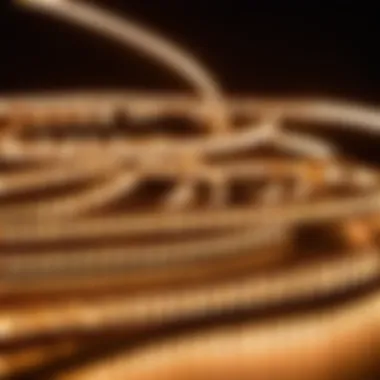Materials:
-
LED strip lights: Purchase high-quality LED strip lights in the required length for your project. Ensure they have the appropriate wattage and color temperature for your intended use.
-
Power supply: Acquire a compatible power supply with the correct voltage to safely operate the LED strip lights.
-
Wire connectors: Prepare wire connectors to establish proper connections between the LED strip lights and the power supply.
-
Mounting clips or adhesive tape: Depending on your installation preference, gather mounting clips or adhesive tape to secure the LED strip lights in place.
-
Scissors: Have a pair of scissors on hand to accurately cut the LED strip lights to the desired length.
-
Tape measure: Use a tape measure to ensure precise measurements when cutting the LED strip lights and determining placement.
-
Cleaning supplies: Before installation, clean the mounting surface thoroughly to promote better adhesion and longevity of the LED strip lights.
DIY Steps:
-
Planning: Measure the area where you intend to install the LED strip lights to determine the required length. Consider the color temperature needed for the desired ambiance.
-
Preparation: Ensure all materials are readily available and that the power supply is connected to a suitable outlet. Familiarize yourself with the installation instructions for the LED strip lights.
-
Installation: Cut the LED strip lights to the measured length using the scissors. Connect the strip lights to the power supply using the appropriate wire connectors. Secure the lights in place using mounting clips or adhesive tape.
Technical Aspects:
-
Tools: Scissors, tape measure, wire connectors
-
Timing: Allocate sufficient time for planning, preparation, and installation to avoid rushed decision-making.
-
Techniques: When cutting the LED strip lights, ensure to do so at designated cut points to prevent damage to the internal components.
DIY Project Process:


-
Sequential Steps: Start by confirming the placement of the LED strip lights, ensuring they align with your initial measurements. Follow the installation instructions provided with the lights for proper setup.
-
Troubleshooting Tips: In case of flickering lights, check for loose connections or insufficient power supply. Adjust the placement if needed to optimize light distribution.
Introduction


Overview of LED Strip Lights
In this section, we delve into the core elements that define LED strip lights, providing a holistic view of their technology, applications, and advantages over traditional lighting solutions. LED strip lights have revolutionized the world of illumination with their efficiency, flexibility, and versatility. By examining the technological aspects, practical applications, and benefits of LED strip lights, readers will gain a profound appreciation for the superior capabilities of this lighting solution.
LED Technology
LED technology represents a remarkable advancement in lighting innovation, characterized by its energy efficiency, longevity, and environmental sustainability. The key characteristic of LED technology lies in its ability to convert electrical energy into light with minimal heat loss, making it a highly efficient lighting option. Unlike traditional incandescent bulbs, LEDs emit light in a specific direction, ensuring that the illumination is focused and wastage is minimized. This directional feature contributes to the energy-saving properties of LED technology, offering a cost-effective and eco-friendly lighting solution.
Applications
The applications of LED strip lights encompass a diverse range of uses across residential, commercial, and industrial settings. From accent lighting to task lighting, LED strip lights excel in providing versatile illumination solutions that cater to various needs. Whether used for creating ambient lighting in homes or highlighting architectural features in commercial spaces, LED strip lights offer unparalleled flexibility and efficiency. Their compact size, low heat output, and customizable features make them an ideal choice for applications that demand precision and aesthetic enhancement.
Advantages over Traditional Lighting
LED strip lights surpass traditional lighting solutions in several key aspects, making them a preferred choice for modern illumination needs. One of the primary advantages of LED strip lights is their energy efficiency, consuming significantly less power to produce the same amount of light as incandescent or fluorescent bulbs. This energy-saving feature not only reduces electricity costs but also contributes to lower carbon emissions and environmental conservation. Additionally, LED strip lights have a longer lifespan than conventional lighting sources, requiring less frequent replacement and maintenance. The durability, color versatility, and low voltage operation of LED strip lights further enhance their appeal as a sustainable and cost-effective lighting option.
Factors Affecting Consumption


LED strip lights have garnered popularity in modern lighting solutions due to their energy efficiency and versatility. In this article, we aim to dissect the pivotal role of Factors Affecting Consumption in optimizing LED strip light usage. By understanding the intricate interplay of wattage, voltage, color temperature, and usage patterns, users can ensure cost-effective and sustainable lighting practices. Examining these factors not only impacts energy consumption but also contributes to environmental conservation and longevity of the lighting system.
Wattage and Voltage
Understanding wattage
Wattage plays a crucial role in determining the power consumption and light output of LED strip lights. Users need to comprehend the relationship between wattage and brightness levels to achieve the desired lighting ambiance efficiently. By selecting the appropriate wattage for their needs, individuals can strike a balance between energy efficiency and illumination quality. Understanding wattage aids in making informed decisions when configuring lighting setups, ensuring optimal performance with minimal energy wastage.
Voltage requirements
Voltage requirements dictate the electrical input necessary for LED strip lights to function effectively. Choosing the correct voltage ensures the longevity and stability of the lighting system. Users must adhere to the specified voltage range to prevent damage to the LEDs and maintain consistent brightness levels. Voltage requirements significantly impact the performance and safety of LED strip lights, emphasizing the need for precise electrical compatibility.
Impact on energy consumption
The wattage and voltage specifications directly influence the energy consumption of LED strip lights. By carefully managing and aligning wattage and voltage with operational requirements, users can maximize energy efficiency and reduce electricity costs. Understanding the impact of wattage and voltage on energy consumption empowers individuals to make informed decisions regarding their lighting usage, promoting sustainable practices and minimizing environmental footprint.
Efficiency Optimization
Dimming Options
Dimmer switches
Dimmer switches play a pivotal role in optimizing the efficiency of LED strip lights, allowing users to adjust the brightness levels according to their needs. The key characteristic of dimmer switches lies in their ability to regulate the intensity of light output, contributing to energy savings and creating ambiance. With the unique feature of adjustable brightness levels, dimmer switches offer flexibility and customization, making them a popular and beneficial choice for users looking to tailor their lighting experience. However, it is essential to consider compatibility with specific LED models and potential flickering issues when using dimmer switches.
Smart dimming technology
Smart dimming technology revolutionizes the control and efficiency of LED strip lights by offering advanced features such as automated brightness adjustment and remote operation. The key characteristic of smart dimming technology is its intelligent controls that optimize energy consumption based on usage patterns and ambient lighting conditions. With the unique feature of connectivity to smart devices, users can remotely manage their lighting settings for convenience and energy efficiency. The advantages of smart dimming technology include seamless integration with smart home ecosystems and preset lighting schedules, enhancing the overall experience of LED lighting. However, complexities in setup and compatibility with existing systems may pose challenges for some users.
Benefits of dimming for energy saving
The benefits of dimming for energy saving are multifaceted, as this feature enables users to reduce power consumption without compromising on lighting quality. The key characteristic lies in the ability to fine-tune brightness levels to achieve the desired illumination while conserving energy. By dimming LED strip lights when full brightness is not required, users can lower electricity costs and extend the lifespan of the lighting fixtures. The unique feature of energy-saving dimming options promotes sustainability and eco-friendly practices, making it a sought-after choice for individuals seeking cost-effective lighting solutions. However, it is important to note that excessive dimming may affect color rendering and overall brightness levels, necessitating a balance between energy efficiency and lighting performance.
Environmental Impact
Sustainability Considerations
Resource Efficiency
Resource efficiency plays a vital role in the discourse of LED strip light consumption. It involves the judicious use of materials and energy to ensure minimal wastage and maximum output. In this article, resource efficiency is highlighted as a cornerstone for sustainable lighting solutions. Its key characteristic lies in optimizing resource utilization to achieve high performance with minimal environmental footprint. The unique feature of resource efficiency is its ability to enhance energy savings and reduce resource depletion, making it a crucial aspect for individuals aiming for eco-conscious lighting solutions.
Waste Generation
Waste generation is a paramount consideration in the environmental impact of LED strip lighting. This subsection addresses how waste generation factors into the overall sustainability of using LED technology. The key characteristic of waste generation lies in understanding the byproducts of manufacturing and utilizing LED strip lights, emphasizing the importance of proper disposal and recycling practices. The unique feature of waste generation is its potential to be minimized through responsible consumption habits and recycling initiatives, contributing to a cleaner and more sustainable environment.
Lifecycle Assessment
The lifecycle assessment of LED strip lights is a critical component in evaluating their environmental impact. This section analyzes the overall lifespan of LED lights, from production to disposal, to determine their sustainability. The key characteristic of lifecycle assessment is its comprehensive evaluation of the environmental implications at each stage of a light's life cycle. In this article, lifecycle assessment is portrayed as a tool for measuring the eco-friendliness of LED strip lighting choices. Its unique feature lies in providing a holistic view of the environmental effects of LED lights, helping consumers make informed decisions that align with their sustainability goals.
Carbon Footprint
In the realm of environmental impact, understanding the carbon footprint of LED strip lighting is imperative. This section explores how LED lights contribute to emissions and energy consumption, shedding light on strategies for reducing their carbon footprint. By delving into the various facets of carbon footprint, individuals can adopt practices that mitigate environmental harm and promote eco-friendly lighting solutions.
Energy Consumption Analysis
Energy consumption analysis forms the crux of evaluating the environmental impact of LED strip lights. This subsection dissects the energy utilization of LED lights in different settings, emphasizing the importance of efficient energy use. The key characteristic of energy consumption analysis is its ability to pinpoint areas where energy efficiency can be improved, showcasing the potential for reducing environmental impact. The unique feature of energy consumption analysis is its role in guiding users towards energy-saving practices that optimize LED strip light consumption, benefiting both the individual and the environment.
Emission Reduction Strategies
Emission reduction strategies are pivotal in combating the environmental effects of LED strip lighting. This section outlines various approaches to minimize emissions associated with LED light usage, highlighting the importance of conscientious energy management. The key characteristic of emission reduction strategies lies in their ability to curb greenhouse gas emissions and promote cleaner energy practices. In this article, emission reduction strategies are portrayed as actionable steps towards achieving a more sustainable lighting setup. Their unique feature lies in offering practical solutions for individuals looking to reduce their environmental impact while utilizing LED strip lights.
Carbon Offset Options
Carbon offset options provide a nuanced understanding of how individuals can balance their carbon footprint when using LED strip lights. This part delves into strategies for offsetting the emissions produced by LED lighting, emphasizing the importance of holistic environmental responsibility. The key characteristic of carbon offset options lies in providing avenues for individuals to invest in sustainability projects that counterbalance their carbon emissions. The unique feature of carbon offset options is their empowerment of users to take proactive measures in mitigating the environmental consequences of LED lighting, promoting a greener and more eco-conscious lifestyle.
Conclusion
Summary of Key Points
Energy-saving Strategies
Diving into the realm of energy-saving strategies within the context of LED strip light consumption, it becomes evident that these strategies form the backbone of efficient and sustainable lighting solutions. Delving deeper into the specifics of energy-saving strategies reveals the various methods and approaches that aim to reduce energy consumption while maintaining adequate illumination levels. One key characteristic of energy-saving strategies is their adaptability to different settings and preferences, making them versatile and widely applicable across diverse scenarios. Their emphasis on reducing electricity costs and minimizing environmental impact underscores why they are a popular choice for individuals seeking to enhance energy efficiency in their lighting setup. These strategies offer a unique feature in their ability to curtail energy wastage without compromising on lighting quality, thus presenting a win-win situation for consumers. While their advantages are clear in terms of long-term cost savings and eco-friendliness, a potential disadvantage lies in the initial investment required to implement certain energy-saving solutions.
Environmental Implications
Exploring the environmental implications associated with LED strip light consumption unveils the profound influence lighting choices can have on sustainability efforts. This aspect delves into how the selection of LED lighting products and usage patterns can directly impact resource efficiency, waste generation, and overall environmental footprint. A key characteristic of considering environmental implications is the conscious effort to minimize negative environmental effects through informed decision-making and responsible usage practices. This deliberation is deemed beneficial within the context of this article due to its alignment with eco-friendly objectives and the promotion of greener lifestyles through simple yet impactful choices. The unique feature of addressing environmental implications lies in the dual benefit of reducing personal carbon footprint while contributing to broader environmental conservation goals. While the advantages are evident in terms of promoting sustainability and conscientious consumption, a potential disadvantage may arise if users fail to adopt sustainable habits consistently.
Future Trends in LED Lighting
Looking towards the horizon of LED lighting, future trends play a pivotal role in shaping the landscape of efficient illumination solutions. Pioneering innovations and advancements within the realm of LED technology form the foundation of these upcoming trends, heralding a new era of smarter, more energy-efficient lighting options. A key characteristic of future trends in LED lighting is their focus on integrating cutting-edge technologies and design principles to meet evolving consumer needs and environmental demands. Their popularity stems from the inherent benefits of enhancing lighting performance, energy efficiency, and customization possibilities, aligning perfectly with the objectives outlined in this article. The unique feature of future trends rests in their ability to transform conventional lighting paradigms and pave the way for sustainable lighting solutions that prioritize both functionality and environmental responsibility. Despite their significant advantages in driving forward sustainable lighting practices and enhancing user experience, a potential disadvantage could be the initial adoption challenges or compatibility issues that may arise with rapidly evolving technologies.





